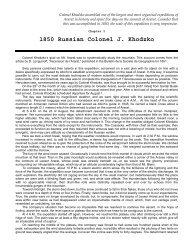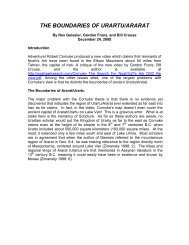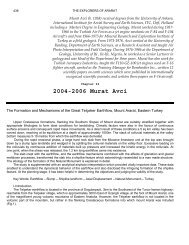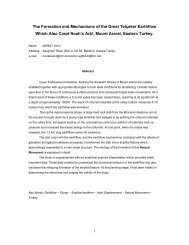1876 British Viscount & Ambassador James Bryce - Noah's Ark Search
1876 British Viscount & Ambassador James Bryce - Noah's Ark Search
1876 British Viscount & Ambassador James Bryce - Noah's Ark Search
You also want an ePaper? Increase the reach of your titles
YUMPU automatically turns print PDFs into web optimized ePapers that Google loves.
150 THE EXPLORERS OF ARARAT<br />
a small Shemakha rug, which we had bought in Tiflis, and lying down upon it with a pair of boots for a pillow. Nothing<br />
could be prettier, or less like the country we had just left. Bare reddish mountain tops rose nearly 4000 feet above us,<br />
and 6000 or 7000 feet above the sea; their densely wooded sides descending steeply into the valley, along whose<br />
narrow but level floor the clear stream rippled along in little runs and pools, where surely trout must play, the sunlight<br />
breaking through the bushes on its sparkling shallows. Delijan itself, which lies scattered up and down the steep<br />
hillside, at a point where two glens meet, is inhabited partly by Armenians, partly by Molokans, a sect of Russian<br />
Dissenters who have been deported hither by the Czars. They are said to have neither baptism nor the Lord’s Supper,<br />
nor any regular clergy; and at their religious meetings follow up the singing and the extempore prayers, which<br />
constitute the service with an odd sort of dance, and kissings all round. They cling to all their old Russian habits, marry<br />
only among themselves, and build their cottages of wood, so that one easily distinguishes their settlements from those<br />
of Armenians or Tatars, even before seeing their beards and characteristically Russian physiognomy.<br />
From Delijan, which we left at seven o’clock in the evening, the well engineered road mounts steeply through a<br />
superbly wooded glen, whose beauties, however, we lost in the darkness. It was midnight before we reached the posthouse<br />
at the top of the pass, where we halted in the hope of a little sleep, having had none to speak of the night<br />
before. Sleep, however, was out of the question. It was bitterly cold, for we were at a height of 7000 feet above the<br />
sea, the room was small, and foul beyond description, and the stony floor one had to lie down upon swarmed—here,<br />
however, let a veil be dropped. Memory called up many a disagreeable night—nights in rock-holes on the Alps, nights<br />
under canvas amid Icelandic snow-storms, nights in Transylvanian forests, nights in coasting streamers off the shores<br />
of Spain, nights in railway waiting-rooms in England, but no night so horrible as this. Descending under the opening<br />
eyelids of the dawn from the pass, which lies among green and rounded hills, we were refreshed by the sight of a<br />
magnificent inland sea stretching away fifty miles to the southward, surrounded by high volcanic hills, all absolutely<br />
bare of trees, and in most places even of grass, but with a few small patches of snow lying here and there in their<br />
upper hollows. It was the lake which the Russians call Goktcha (a corruption of the Tatar name, which means blue<br />
lake), and the natives Sevan, the Lychnitis of the ancients; and we were now fairly in Armenia. Unlike the two other<br />
great lakes of that country, that of Van in the Turkish dominions and that of Urumia in the Persian, its waters are fresh<br />
and it discharges by a small river, the Zenga, into the Aras. The mountains round it are all of volcanic origin, and rise<br />
some 4000 to 5000 feet above its surface, which is over 5870 feet above the sea. A great part of it freezes in winter.<br />
The beach, at the place where I bathed, was composed of large volcanic pebbles, glued together by and incrusted with<br />
a thick calcareous deposit, which forms all around the shores a white line, marking the difference between the summer<br />
and winter level of the water. The only village we could descry lies just opposite the only island, whereon is the ancient<br />
and famous Armenian monastery of Sevan or Sevanga. Even the Armenian fathers of the little monastery in the lake,<br />
which at one time claimed to be the seat of the Patriarch of the Armenian Church, own with a sigh that the age of<br />
miracles is past.<br />
Hamlets lie scattered in the glens, and here and there woods of dwarf oak hang on the steep sides of the glens,<br />
giving the landscape a softer and more cheerful look than this part of Armenia generally has. At the top of the long,<br />
steep slope down which the village of Daratchitchak meanders stand three curious old churches, built of huge blocks<br />
of a reddish volcanic stone. The two larger of them have been partly destroyed in some of the numerous Tatar<br />
irruptions; but the smallest is entire, covered, like all Armenian churches, by a high polygonal cupola, and has a pretty<br />
little portico, whose doorway is divided into two by a miniature, elegantly carved, Romanesque column, supporting two<br />
slightly pointed arches, a charming piece of work, which reminded us of Western forms more than anything we had yet<br />
seen in these countries.<br />
The vice-governor and his wife courteously welcomed us. He smiled when we asked, through the lady, who acted<br />
as interpreter, about Ararat, told us that it had never been really ascended, though several travelers professed to have<br />
got up, and evidently thought the enterprise hopeless. Ala Göz consists of three sharp, rocky peaks, apparently parts<br />
of the rim of an ancient crater, rising out of an immense swelling upland some forty miles in circumference. The peaks,<br />
one of which is said to be inaccessible, and certainly looks as though it might afford nice bits of climbing, are too<br />
abrupt to bear snow, but we afterwards saw patches of white in the bottom of the extinct crater between them. It is<br />
even said that there is a small glacier there; I cannot think, however, the snow is sufficient in quantity to feed one. Ala<br />
Göz is a curious instance of the untrustworthiness of one’s impressions about the height of mountains. After Ararat, it<br />
is the loftiest summit between the Caucasus and the Persian Gulf, 13,436 feet above the sea, as high as the<br />
Schreckhorn or Piz Bernina. If we had judged by our eyes, we should have put it down at 9000 feet. I have never seen<br />
so high a hill look so inconsiderable, so perfectly mean and trivial. It is true that the point whence we first caught sight<br />
of it was 5000 feet above the sea; but afterwards, looking at it from the plain of the Aras, and from the top of Ararat, it<br />
seemed no higher, owing, no doubt, to the gentleness of its lower slopes and to the way one miscalculates distance in<br />
this clear, dry atmosphere.<br />
It is a bare and dreary country, like all the interior of Armenia, perfectly brown, and apparently almost waterless;<br />
but the volcanic soil is very rich, and would support a population far larger than that which now occupies it. Everything<br />
is primitive to the last degree: there was not even a morsel of food, nor a drop of vodka. Every post-house, however<br />
simple, possesses a samovar, a huge brazen urn with a cylinder in the middle, into which the charcoal is put to boil the<br />
water. As soon as you enter the station, you call for the samovar; in fifteen or twenty minutes the hot water is ready.<br />
Then you put in the tea, slice down the lemons, and tumble in the sugar, which articles you have, of course, brought









